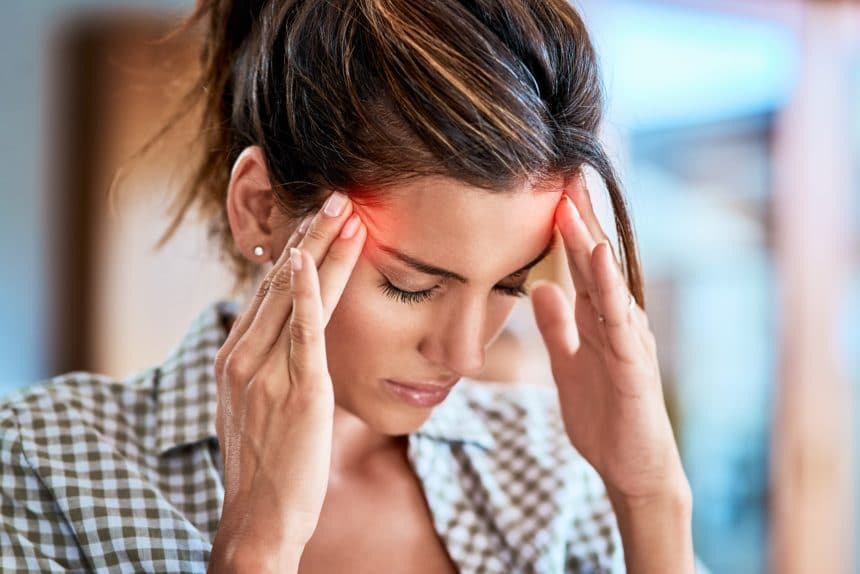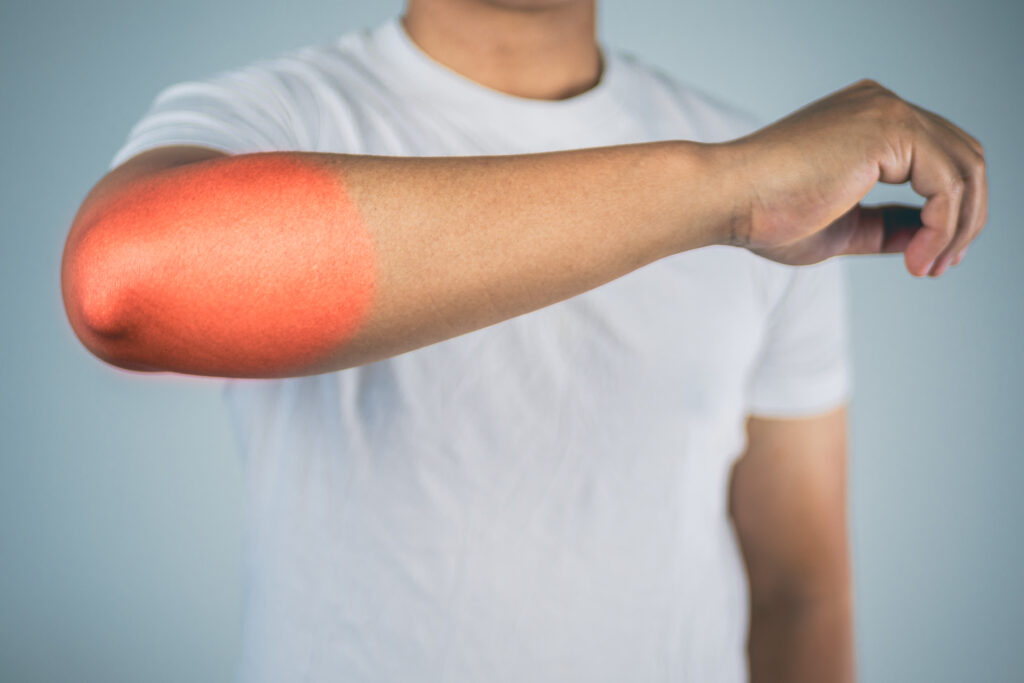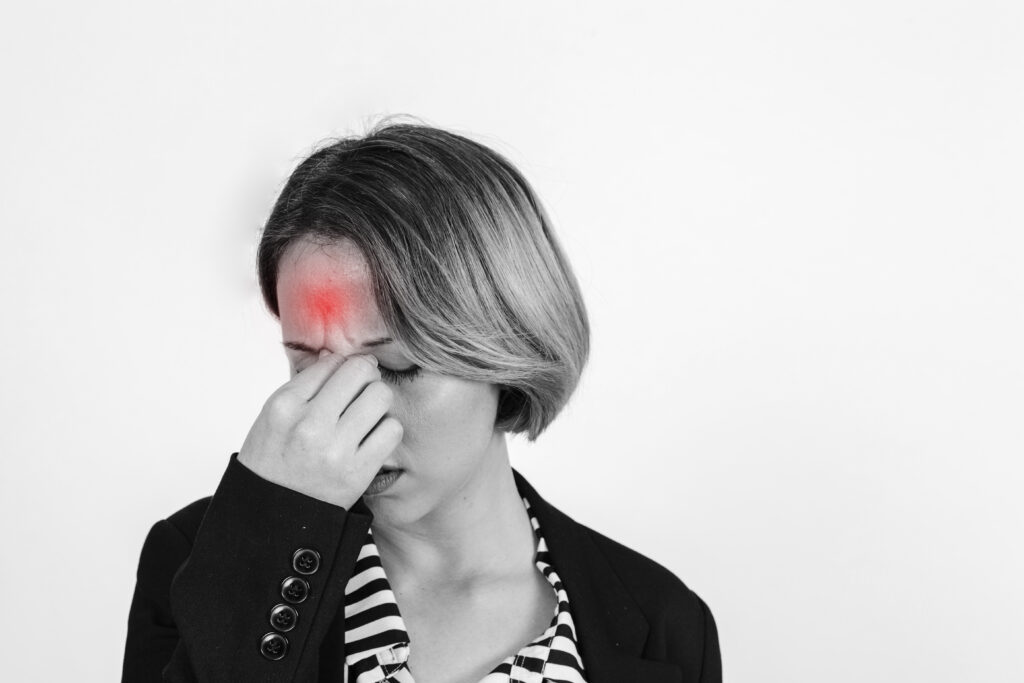Headaches… What’s the true cause and how to naturally reduce or eliminate them.
Table of Contents
What’s common among all headaches?
Sources of irritation to nerves of the head.
One Approach that can help reduce or eliminate all types of headaches
The Most Common Types of Headaches, their causes, and natural and effective remedies.
Introduction
Just after Low Back Pain, Headaches are the #2 cause of disability in the world. And with half of all adults in this country suffering from headaches, our understanding and care-management for them are vital!
Did you know there are over 50 different classifications of Headaches? Thankfully they share a lot of common causes, which when properly addressed can greatly reduce or eliminate the headaches.
The common approach to headache management is to first determine the type, then prescribe a drug. The drug could be an over the counter NSAID, to a more serious anti-depressant or anti-seizure medication. We have seen some of our patients start care with serious medications for their headaches, unfortunately often with serious side effects too.
One of our headache patients had tried numerous approaches, one being an anti-seizure medication that she used for almost a year. During that period numerous friends and family commented on how her personality had changed. She was still suffering from headaches so she decided to get off the medication. Since that time her memories of that year are a daze, and she struggles to remember any detail that happened during that time.
We provide a contrasting approach…
Our aim is not to diagnose a specific class of headache – We aim to simply improve overall health and restore the body to normal function. When health and function are restored healing and symptom reduction are a natural result.
While there are certainly headaches caused by medications and drugs and their withdrawal (rebound headaches). There has NEVER BEEN and never will be a headache caused by a lack of Aspirin or other Medications. These drugs are altering body chemistry to reduce pain, they do not address the root cause of the problem.
So what causes headaches then…
Surprising as it may sound there are no pain receptors in the brain. So all headaches originate outside of the brain itself. The irritated tissues that cause headaches can be very close to the brain like the blood vessels and the meningeal covering of the brain, or far like your digestive tract.
But no matter the source of irritation or type of tissue irritated all headaches have one thing in common… besides of course being a pain in your head.
Drumroll, please…….
What’s Common Among all Headaches?
The Trigeminal Cervical Nucleus. The what….

The trigeminal cervical nucleus is where 3 branches of the trigeminal cranial nerve, and nerve roots from C1, C2, and C3 meet in the brainstem and upper spinal cord. It also has relays, for the spinal accessary nerve, facial nerve, and glossopharyngeal nerve and vagus nerve (this will be important later). This trigeminal cervical nucleus is located in the upper neck. Why is this area a commonality in all headaches…? All head pain is regulated and relayed here before it goes up to the cortex and we become consciously aware of the pain. There are many areas of the body that have nerve relays here in the trigeminal cervical nucleus. We are not consciously aware all of the nerve signals from every tissue all the time. The nerve signals that get passed through to our conscious awareness in the cortex is regulated here in the trigeminal cervical nucleus. What we become aware of is based off of the type of signal (pain or other sensory) and intensity of that nerve signal.
This is so vitally important because irritation to any of nerve or tissue that causes headaches will be regulated here. This also means all of these areas are linked together, so function or dysfunction of one area will influence the function of the other. This is why headaches can have so many different presentations, because these nerves innervate so many different tissues, joints, muscles, and organs.
Sources of irritation to nerves of the head.
Here’s a list of nerves involved with headaches. Along with the tissue innervated and common symptoms of irritation.
- Trigeminal Nerve- Ophthalmic Branch
- Skin of the forehead and scalp (tension)
- Eyelashes, eyelids (Sty)
- Tear ducts, and the whites of your eyes (light sensitivity, dry eyes)
- Sinuses (pressure)
- Trigeminal Nerve- Maxillary Br.
- Skin of the nose, and upper face (smell sensitivities)
- Upper teeth, gums, palate, sinuses. (oral health issues, mercury fillings)
- Trigeminal Nerve- Mandibular Br.
- Tempo-mandibular joint, muscles of chewing (Jaw Pain, clinching, grinding, dental alignment)
- Lower teeth, gums
- Mandibular Br. also Interacts with other nerves of the face and head…
- Salivary gland function (dry mouth)
- Hearing (sound sensitivity)
- Taste (smell and taste aversions and triggers)
- Swallowing (difficulty to swallow, or speak)
- Trigeminal Branches also innervate blood vessels of the head and brain (migraines, caffeine withdrawal, and blood pressure or air pressure changes).
- Spinal Nerve Roots C1-3, And Spinal Accessary Nerve
- Spinal Joints, Discs (subluxation, posture)
- Muscles of the upper neck, base of skull (tension, stress, trigger points)
- Muscles of anterior neck, (posture, whiplash injury)
- Trapezius muscle, Upper back and shoulder blade muscles (Posture, Trigger points)
- Vagus Nerve
- Sensory from the ear (ear infections)
- Throat, glands, voice box (seeking quiet)
- Our “Gut Feel” of digestion (reflux, indigestion), heart (anxiety, racing heart rate)
- Glossopharyngeal Nerve
- Muscles of the throat (swallowing, speech changes)
- Taste from the tongue (changes in taste, food triggers)
- Facial Nerve
- Muscles of the face, Facial Expression (facial tension)
- Taste from the tongue
This is not an Exhaustive list…
Because all these areas interact through the trigeminal cervical nucleus, irritations from one area can create dysfunction in another area. For example a neck injury can create muscle spasm and tension, this tension can then irritate your ophthalmic nerve creating sensitivity to light, and now more light can create more headache even though there is no problem with your eyes. This is why headaches can cause such a variety of related symptoms, and why there are so many secondary causes of the feelings of headache (causes outside of the head). This cyclical aspect of headaches is why learning about how to regulate the pain at the trigeminal cervical nucleus is so important for headache treatment.
One Approach that can help reduce or eliminate all types of headaches
So what can we do naturally to reduce irritation and cross irritation of this trigeminal cervical nucleus?
SLAM the DOOR on PAIN signals…
In this case it’s actually a gate, called the pain gate, so let’s SLAM the PAIN GATE Closed!
Irritations to any tissue are transmitted to the brain, on pain or nociceptive nerve fibers. These fibers are travelling along all the nerves listed above to the trigeminal cervical nucleus. There is a Superhero that loves to slam the gate on pain (think Gandalf and the “you shall not pass” scene).

Who is this Amazing superhero…? Proprioception.
Who?!? Proprioception is movement stimulation.
This is where the spine really comes into play, not only is the spine a common source of headache pain. Over 20% of chronic headaches are cervicogenic, meaning they are caused by irritation of spinal joints and discs of the neck, and if we factor in tension headaches which arise from tension in muscles of the neck primarily but also muscles of the head, upper back, face, and traps as well. We are well over 50% of headaches being caused by dysfunction in the neck.
So the spine is one of the biggest causes of headaches.
Spinal subluxations are misalignments of spinal bones. The subluxation then causes mechanical irritation to joints, discs, and ligaments. This also creates postural shifts, guarding, and tension in the muscles of posture and spinal movement which is the most common source of tension headaches.
When subluxations are corrected in the spine, it restores natural movement, which RESTORES PROPRIOCEPTION our Superhero.
The increased Proprioception then travels through the trigeminal cervical nucleus and SLAMS the PAIN GATE CLOSED. “You Shall Not PASS!”
So when we increase quality movement into the neck we excite the proprioceptive nerves going to the trigeminal cervical nucleus which numbs or blocks all the pain nerve fibers relaying from all the possible sources of irritation we listed above. YES… Very powerful!
So what you’re saying is no matter the type of headache, or source or irritation getting adjusted can help reduce the headache by desensitizing my brain to the pain stimulus… YES I know it’s pretty awesome. BUT let’s not stop there.
The Most Common Types of Headaches, their causes, and natural and effective remedies.
Like we discussed above the neck is a common cause of headaches but it is certainly not the cause of all of them. Now we get to the tools we can use by ourselves, and with other health care providers for each of the type of headache.
But remember the cross healing and cross irritation theory at the trigeminal cervical nucleus. Some causes may be difficult to determine or eliminate, but we can heal irritated tissues through proprioceptive input into the trigeminal cervical nucleus.
Now let’s look at common types of headaches, how they feel, what causes them, and natural and effective treatments.
Tension Headaches

- The most common headache, 1 in 20 people suffer with a chronic daily tension headache. Statistics shows 48% of women and 38% of men have tension headaches.
- Mild to serve pain levels
- Often equal on both sides with band-like tension
Techniques that address the true cause and help reduce tension include.
Chiropractic Adjustment
- Decrease pain perception though Trigeminal Cervical Nucleus
- Correct spinal subluxations that cause muscle tension
- Posture improvement which will also reduce muscle tension
- decrease nerve irritation, which decreases stress and tension
Massage and Self Massage
- decrease muscle tension and promotes relaxation
- breaks up adhesions within the muscles to improve muscle and tissue health
- Self- Massage provides feedback to our brain about our tension levels, which can help us relax tight muscles through our awareness and breathing techniques.
Magnesium Supplementation
- Deficiency leads to increased tension and spasm and overall decrease in Muscle Performance
- Magnesium L-threonate – best for brain health
- Magnesium glycinate – best for stress reduction
- Magnesium citrate – Muscle Relaxation
- Magnesium sulfate – Muscle Relaxation (Epsom salt bath)
Breathing, Relaxation techniques, and exercise
- Stress builds physical tension in muscles
- Relaxation breathing, Yoga Breathing, and other techniques are great a reducing tension and decreasing the effects of stress on our physical body
- Exercise is one of the most powerful ways to decrease the effects of stress on the body.
- However exercising with poor posture, or spinal health issues will increase tension patterns so good chiropractic care is vital to get the full benefits of exercise and prevent further injury.
Cervicogenic Headaches are caused by injury or irritation to tissues of the neck.
- 15-20% of all headaches
- Commonly confused with migraines due to their intensity and pain pattern.
- Caused by neck dysfunction due to poor posture, injury (ex. Whiplash or disc injury), “pinched nerves,” and neck misalignments or subluxations.
- Bilateral or single sided depending on where the neck injury is located.
- Neck pain may or may not be present.


Migraine Headaches
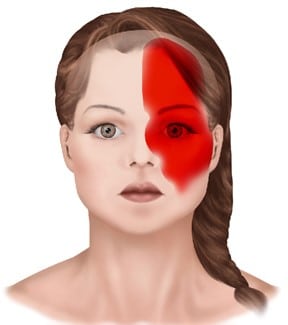
- 18% of women and 9% of men have migraines
- Longer lasting attacks from 4- 72 hours
- Often single sided, but can be bilateral (bilateral is more common in children)
- Pulsing throb quality
- moderate to severe pain
- nausea is common
- sensitivity to light and/or sound
- With Aura – has the above and…
- Changes in vision, smell, taste, speech, and muscle weakness and/or fatigue.
- Usually has a building or prodromal period of hours to days.
Causes and triggers for Migraines are not as well understand as other forms of headache. The specific cause can also vary greatly from person to person, so working on tools to improve overall health are key (Exercise, Sleep, Diet, Nerve Flow, Mental Health).
We recommend Chiropractic for Migraines as primary form of care because it addresses most direct causes all at once. Direct causes are thought to include: Nerve irritation, brain stress levels, restricted vascular flow and drainage, hormone regulation (related to stress levels), meningeal irritation (brain and nerve coverings).
The chiropractic adjustment decreases migraine pain levels through the gate theory described above, which helps with all causes of migraines. Another really important aspect of chiropractic care is how it improves the blood flow into and out of the head.
One research study found the meningeal arteries of the brain did dilate and expand over 300% in migraine attacks, overall blood flow was not significantly increased. This indicates there is decreased blood drainage out of the head in the presence of neck misalignments or subluxations. This back pressure is thought to be a primary cause of irritation to blood vessels and tissues of the head causing migraines.
The adjustment also improves activity in certain parts of the brain (the Pre-Frontal Cortex) which reduces the overall stress levels and improves brain health and performance.
Below are many other tools we recommend to our patients that have been very helpful.
Eliminate Excito-toxins – Aspartame, Aspartate, MSG, and cysteine (for full list see link below). Excito-toxins have been linked to a variety of neurologic conditions including migraines due to their damaging affects to nerve cells. (see full ingredient list in reference at the bottom)
Exercise – Overall health improvements, decreasing stress levels, and improving vascular health. Specific kinds of Exercise include Nitric Oxide and HIIT training.
- Nitric Oxide work out – video link below
- Do not do in the middle of a migraine
- Improves vascular health
- NO and HIIT training can also improve overall metabolic health
- Low intensity Aerobic training can be helpful during migraine periods
Diet – Main goal here is to improve metabolic health, stabilize blood sugars, improve the body’s ability to burn fat for energy.
- There are migraine theories that suspect poor blood sugar regulation in the body may be a significant driver of migraine attacks.
- Re-training your body to burn fat as a resource will stabilize your blood sugar levels.
- If the brain is becoming insulin resistant due to poor metabolic health (diabetes), many different neurologic symptoms and decline are possible including migraines.
- Low Carb – High Fat, Intermittent Fasting, Fasting, and Keto are all forms of Diet modifications aimed at improving overall metabolic health, and the bodies ability to burn fat as a resource.
- A secondary purpose of diet modification would be to decrease overall inflammation levels and identify possible triggers.
- Many people have food sensitivities they are unaware of, these sensitivities increase gut and whole-body inflammatory levels.
- 20% of migraines have food triggers, however because migraines often have multiple causes and food quality and chemical ingredients can vary greatly specific food triggers can be difficult to pin point.
- Good article for food triggers in references below
- Elimination diets can help identify triggers and food sensitivities.
Supplements to add. All of the below have been found in research to significantly decrease frequency and intensity of migraines.
- Vit D – Decrease inflammation and Pain
- 5000-10000 IU/ day for 3 months, then 5000 IU/day afterwards
- B Complex, B2, B6, B12, and Folate
- B2 in high does can ABORT a MIGRAINE
- Co Q10 – Metabolic health, specifically mitochondrial health for better energy production.
- Magnesium L-threonate – best for brain health
- Magnesium IV Treatments – ABORT a MIGRAINE
- Caffeine – but not too much, can create rebound headaches. Don’t exceed 200mg, most people stay below 100mg for headache reduction benefits
Other Relief Techniques
- Cold therapy
- Relief of migraine in process ex. Place cold pack on top of neck or over pain area.
- Ice bath immersion, cold showers, Wim Hof Technique
- Vascular Health improvement and Neuro-Cognitive protection
- Lavender Essential Oil
- Massage into temples
- Dilute in carrier oil and place under upper lip and in nostril
- Acupressure Points
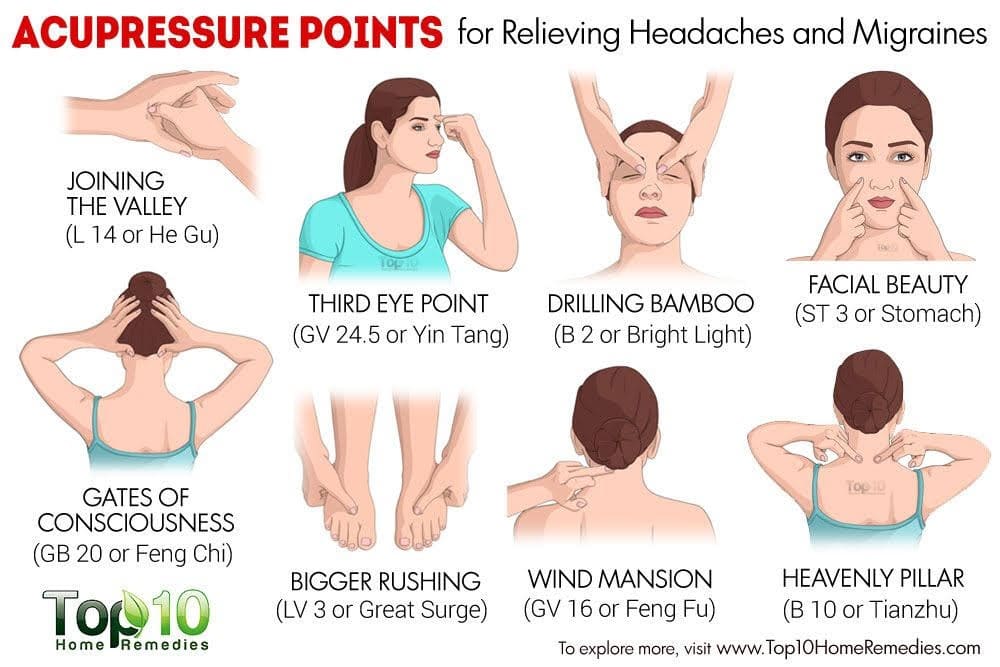
Cluster Headaches

- The least common form of headache (0.1% of the population)
- Single-sided
- In and around the eye or temple
- Puffy eye and tearing
- Stabbing quality
- Very Severe pain in short bursts, that can be accompanied by Aura described above
- Occur in clusters or attacks lasting hours to days.
- Attacks are separated with long periods of no symptoms.
Natural Treatment Strategies overlap with migraines, look to the migraine section for best approaches.
Sinus Headaches
Sinus headaches are caused by irritation and pressure in sinus cavities of the skull. These are associated with sinus infections, ear infections, colds, congestion, and allergies.
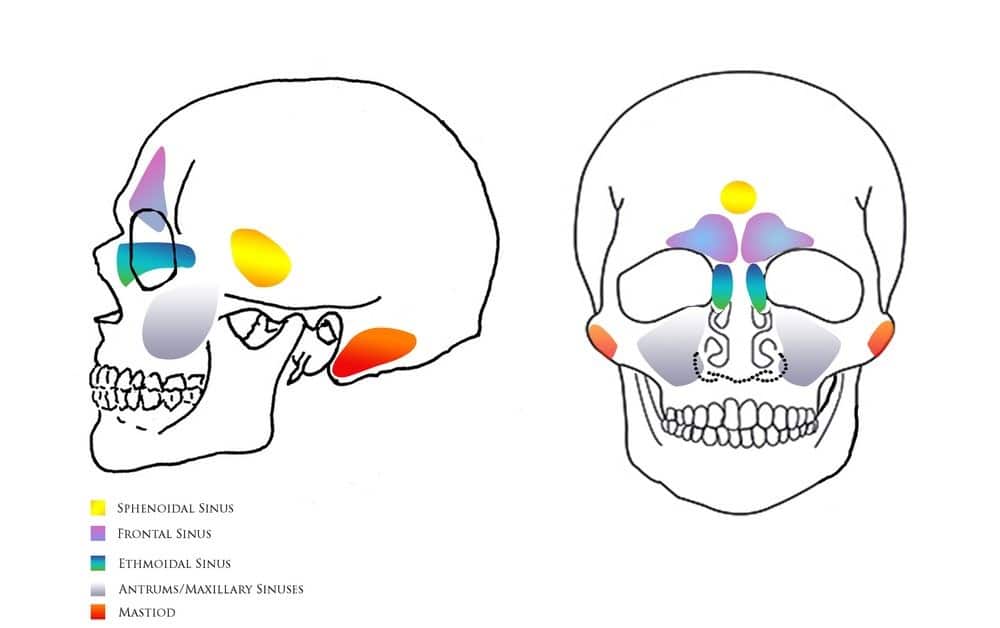
Benefits of Chiropractic care for Sinus Headaches.
The chiropractic adjustment helps restore normal blood flow into and out of the head, this helps decrease sinus pressure by increasing the drainage out of the sinuses. The adjustment has also been shown to increase your immune response in numerous studies, which will help your body process the infection, cold congestion, or ear infection more quickly and therefore decrease sinus headache duration and intensity.
A specific chiropractic technique we utilize called cranial-sacral technique greatly reduces sinus pressure and congestion. Our patients frequently state they feel the pressure drainage by the time they leave out the office!
Other techniques to help decrease sinus headaches include.
Allergy and chronic inflammation reduction
- Elimination Diet
- Fish Oil Supplementation – 3000mg/day
- Vit D – 5000-10000 IU/ day for 3 months, then 5000 IU/day afterward
Immune Boost
- Garlic, Vit D, Colloidal Silver, and Ginger
- See Immune Boosting Video Series (Video Link Here)
Congestion and Pressure release
- Nose breathing
- Steam
- Eucalyptus Essential Oil
- Tapping technique See video for a demonstration
References and Extra Resources
https://www.ncbi.nlm.nih.gov/pmc/articles/PMC3201065/ – CERVICOGENIC HEADACHES: AN EVIDENCE-LED APPROACH TO CLINICAL MANAGEMENT
https://www.ncbi.nlm.nih.gov/pmc/articles/PMC6502880/ – The effects of chiropractic spinal manipulation on central processing of tonic pain – a pilot study using standardized low-resolution brain electromagnetic tomography (sLORETA)
https://www.ncbi.nlm.nih.gov/pubmed/31001596 – Increase in cerebral blood flow indicated by increased cerebral arterial area and pixel intensity on brain magnetic resonance angiogram following correction of cervical lordosis.
https://www.ncbi.nlm.nih.gov/pubmed/31462990 – Effectiveness of chiropractic manipulation versus sham manipulation on recurrent headaches in children aged 7-14 years, Protocol for a randomized clinical trial
https://www.ncbi.nlm.nih.gov/pubmed/28738895 – Chiropractic spinal manipulative therapy for cervicogenic headache: a single-blinded, placebo, randomized controlled trial.
https://www.ncbi.nlm.nih.gov/pubmed/28167971– Glucose Metabolic Changes in the Brain and Muscles of Patients with Nonspecific Neck Pain Treated by Spinal Manipulation Therapy: A [18F]FDG PET Study.
Excitotoxin list- https://autismrecoverysystem.com/wp-content/uploads/2017/05/Glutamate-and-Excitotoxin-Food-List.pdf
NO workout- https://www.youtube.com/watch?v=qEui9ImJaiI
Good article for food triggers- https://my.clevelandclinic.org/health/articles/9648-headaches-and-food
Magnesium Article – https://www.vitacost.com/blog/vitamins-supplements/supplements/types-of-magnesium.html
